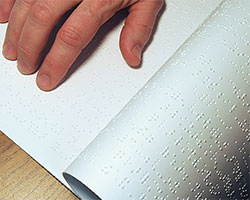 Implications for Learning
Implications for Learning
The impact of vision loss differs from person to person depending on level of severity, compensatory strategies developed, and accommodations used in the past. Consequently, even though two students may have vision loss, the impact may be different and the accommodations may vary. Depending on the degree of the vision loss and the stimulation students have had before reaching postsecondary studies, they may have greater or lesser needs.
Typically, however, students with vision loss will be unable to access written materials without the aid of some tool (such as a text-to-speech software program) or modification of printed text (such as enlarged or high-contrast print). In addition, students with a vision loss may be unable to see material that is presented to the class on chalkboards, smart boards, or any other device displaying visual information.
In addition, students with vision loss, like students with other perceptual disabilities, may face social, physical and mobility barriers during day-to-day activities due to a lack of understanding around these types of disabilities. In a survey of postsecondary administrators, teachers, and instructors at Canadian colleges and universities, Reed (n.d) observed that this lack of understanding may lead to lack of engagement, social isolation, resistance or failure to consistently provide accommodations, and challenges finding field and work placements for students with vision loss.
Nevertheless, Reed and Curtis (2012) report that the program completion rates of blind or partially sighted students in postsecondary education programs in Canada are high, suggesting that with the aid of appropriate supports, assistive technology, and accommodations, blind or partially sighted students can be successful in postsecondary studies.
The following accommodations are a list of suggested accommodations, but are not comprehensive or exhaustive, nor will all accommodations listed be necessary in all cases. Other accommodations may be implemented based on the individual needs of each student as recommended by your campus Disability Services Office or other professionals.
| Common Characteristics of a Student with Chronic with Vision Loss | Commonly Suggested Accommodations/Classroom Adaptations |
|---|---|
| Difficulty reading tests, handouts, viewing diagrams, pictures, slides, or notes on board. | Additional time on tests; provision of a reader; alternate seating location; provide hard copy; enlarged text; braille transcription; alternate format for presentations; assistive technology; verbal description. |
| Difficulty with written assignments. | Provide access to speech-to-text software; provide oral presentation option instead of written assignment. |
| Cannot navigate new or altered classroom setup. | Permit use of an attendant or service animal. |
| Difficulty reading black on white text. | Provide handouts and exams on specifically identified colour paper. Collaborate with DSO for guidance. |